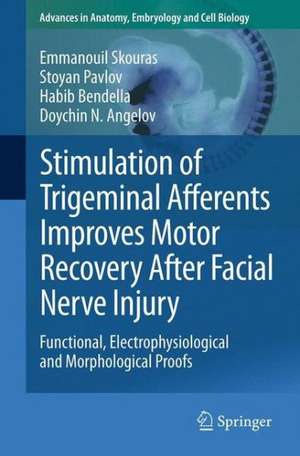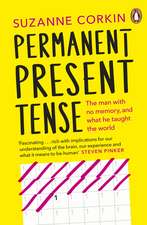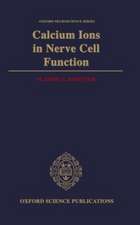Stimulation of Trigeminal Afferents Improves Motor Recovery After Facial Nerve Injury: Functional, Electrophysiological and Morphological Proofs: Advances in Anatomy, Embryology and Cell Biology, cartea 213
Autor Emmanouil Skouras, Stoyan Pavlov, Habib Bendella, Doychin N. Angeloven Limba Engleză Paperback – 16 dec 2012
Din seria Advances in Anatomy, Embryology and Cell Biology
- 5%
 Preț: 1146.33 lei
Preț: 1146.33 lei - 5%
 Preț: 721.19 lei
Preț: 721.19 lei - 15%
 Preț: 637.13 lei
Preț: 637.13 lei -
 Preț: 381.81 lei
Preț: 381.81 lei - 15%
 Preț: 644.95 lei
Preț: 644.95 lei - 5%
 Preț: 1025.16 lei
Preț: 1025.16 lei - 15%
 Preț: 689.97 lei
Preț: 689.97 lei - 15%
 Preț: 577.07 lei
Preț: 577.07 lei - 15%
 Preț: 580.36 lei
Preț: 580.36 lei - 5%
 Preț: 393.51 lei
Preț: 393.51 lei -
 Preț: 408.66 lei
Preț: 408.66 lei -
![Die Schlüpfdrüse der Geburtshelferkröte (Alytes o. obstetricans [LAURENTI]) und anderer Froschlurche](https://i4.books-express.ro/bs/9783662239742/die-schluepfdruese-der-geburtshelferkroete-alytes-o-obstetricans-laurenti-und-anderer-froschlurche.jpg) Preț: 408.27 lei
Preț: 408.27 lei - 5%
 Preț: 1090.61 lei
Preț: 1090.61 lei - 5%
 Preț: 705.11 lei
Preț: 705.11 lei - 5%
 Preț: 706.04 lei
Preț: 706.04 lei - 5%
 Preț: 357.61 lei
Preț: 357.61 lei - 5%
 Preț: 704.59 lei
Preț: 704.59 lei - 5%
 Preț: 705.11 lei
Preț: 705.11 lei - 5%
 Preț: 359.42 lei
Preț: 359.42 lei - 5%
 Preț: 711.52 lei
Preț: 711.52 lei - 15%
 Preț: 635.47 lei
Preț: 635.47 lei - 15%
 Preț: 631.72 lei
Preț: 631.72 lei - 15%
 Preț: 633.35 lei
Preț: 633.35 lei - 15%
 Preț: 632.37 lei
Preț: 632.37 lei - 5%
 Preț: 706.60 lei
Preț: 706.60 lei - 15%
 Preț: 631.07 lei
Preț: 631.07 lei - 5%
 Preț: 707.13 lei
Preț: 707.13 lei - 5%
 Preț: 707.33 lei
Preț: 707.33 lei - 5%
 Preț: 359.60 lei
Preț: 359.60 lei - 5%
 Preț: 707.69 lei
Preț: 707.69 lei - 5%
 Preț: 707.13 lei
Preț: 707.13 lei - 5%
 Preț: 708.06 lei
Preț: 708.06 lei - 5%
 Preț: 706.41 lei
Preț: 706.41 lei - 5%
 Preț: 708.78 lei
Preț: 708.78 lei - 5%
 Preț: 705.68 lei
Preț: 705.68 lei - 5%
 Preț: 705.11 lei
Preț: 705.11 lei - 5%
 Preț: 706.77 lei
Preț: 706.77 lei - 15%
 Preț: 635.15 lei
Preț: 635.15 lei - 15%
 Preț: 631.07 lei
Preț: 631.07 lei - 5%
 Preț: 706.77 lei
Preț: 706.77 lei - 5%
 Preț: 706.04 lei
Preț: 706.04 lei - 5%
 Preț: 710.79 lei
Preț: 710.79 lei - 5%
 Preț: 705.32 lei
Preț: 705.32 lei - 15%
 Preț: 633.19 lei
Preț: 633.19 lei - 15%
 Preț: 629.09 lei
Preț: 629.09 lei - 15%
 Preț: 633.53 lei
Preț: 633.53 lei - 15%
 Preț: 632.70 lei
Preț: 632.70 lei - 15%
 Preț: 633.68 lei
Preț: 633.68 lei - 18%
 Preț: 773.72 lei
Preț: 773.72 lei - 15%
 Preț: 630.43 lei
Preț: 630.43 lei
Preț: 631.86 lei
Preț vechi: 743.37 lei
-15% Nou
Puncte Express: 948
Preț estimativ în valută:
120.90€ • 126.69$ • 99.95£
120.90€ • 126.69$ • 99.95£
Carte tipărită la comandă
Livrare economică 12-26 aprilie
Preluare comenzi: 021 569.72.76
Specificații
ISBN-13: 9783642333101
ISBN-10: 3642333109
Pagini: 128
Ilustrații: XV, 110 p.
Dimensiuni: 155 x 235 x 7 mm
Greutate: 0.18 kg
Ediția:2013
Editura: Springer Berlin, Heidelberg
Colecția Springer
Seria Advances in Anatomy, Embryology and Cell Biology
Locul publicării:Berlin, Heidelberg, Germany
ISBN-10: 3642333109
Pagini: 128
Ilustrații: XV, 110 p.
Dimensiuni: 155 x 235 x 7 mm
Greutate: 0.18 kg
Ediția:2013
Editura: Springer Berlin, Heidelberg
Colecția Springer
Seria Advances in Anatomy, Embryology and Cell Biology
Locul publicării:Berlin, Heidelberg, Germany
Public țintă
ResearchCuprins
First major set: mild indirect stimulation of the trigeminal afferents after combined surgery on the infraorbital and facial nerves by removal (clipping) of the contralateral vibrissal hairs.- Second major set: intensive indirect stimulation of the trigeminal afferents after facial nerve surgery by extcision of the contralateral infraorbital nerve.- Third major set: direct stimulation of the trigeminal and facial nerves after facial nerve surgery by massage of the vibrissal muscles .- Fourth major set: direct stimulation of the trigeminal and facial nerves after facial nerve surgery by application of electric current to the vibrissal muscles.- RESULTS.- Mild indirect stimulation of the trigeminal afferents after combined surgery on the infraorbital and facial nerves by removal of the contralateral vibrissal hairs improves vibrissal function.- Intensive indirect stimulation of the trigeminal afferents by excision of the contralateral ION attenuates the degree of collateral axonal branching and improves the accuracy of muscle reinnervation.- Direct stimulation of the trigeminal and facial nerves by massage of the vibrissal muscles improves the quality of target reinnervation and promotes full recovery of whisking function.- Direct stimulation of the trigeminal and facial nerves by electric current to the vibrissal muscles fails to improve quality of target reinnervation and does not promote recovery of vibrissal function.- DISCUSSION.- Mild indirect stimulation of the trigeminal afferents by removal of the contralateral vibrissal hairs has a beneficial effect on motor recovery.- Beneficial effect of the intensive indirect stimulation of the trigeminal afferents by excision of the contralateral ION.- Complete recovery of motor function after direct stimulation of the trigeminal and facial nerves by massage of the vibrissal muscles.- Deleterious effect of the direct stimulation of the trigeminal and facial nerves by application of electric current to the vibrissalmuscles . - conclusion.- References.
Textul de pe ultima copertă
Its is commonly known that the recovery of mimic functions after facial nerve injury is poor: a successful regrowth of the lesioned axons to their muscle targets is compromised by (i) poor navigation of the growth cones and excessive collateral axonal branching, (ii) abnormal exchange of nerve impulses between adjacent regrowing axons and (iii) insufficient synaptic input to the facial neuronal cell bodies in the brainstem. As a result, axotomized motoneurons become hyperexcitable and unable to discharge. Since the improvement of growth cone navigation and the reduction of the ephaptic cross-talk between axons both turn out be impossible at present, the authors focused their efforts on the third detrimental component and proposed that an intensification of the trigeminal input to the axotomized and electrophysiologically silent facial motoneurons might improve the specificity of reinnervation. To test their hypothesis, they compared behavioral, electrophysiological and morphologicalparameters after single reconstructive surgery on the facial nerve (or its buccal branch) with those obtained after identical facial nerve surgery but combined with indirect (removal of the contralateral infraorbital nerve, ION) or direct (massage of the mimic muscles) stimulation of the ipsilateral ION. They found that in all cases any trigeminal stimulation was beneficial for the outcome by improving both the quality of target reinnervation (reduced polyinnervation of the motor endplates) and the recovery of vibrissal motor performance (as judged by video-based motion analysis). Based on these results, the authors conclude that trigeminal stimulation is a non-invasive procedure with immediate potential for clinical rehabilitation following facial nerve reconstruction.
Caracteristici
The recovery of mimic function after facial nerve transection is still poor and research for better results much needed Written by experts in facial nerve reconstruction with immediate potential for clinical rehabilitation following facial nerve reconstruction D.N.Angelov is a well known author in this field Includes supplementary material: sn.pub/extras














